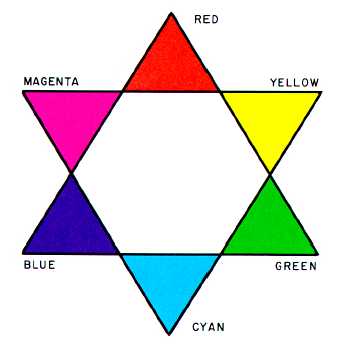Figure 12-2.–Color star.
C303.74
This whole concept of color by subtraction may
seem confusing at first, but if you accept this concept, it
will suddenly become very clear. Color printing is built
around color by subtraction.
COLOR STAR
To help understand color theory, draw a color star
and use it through the color process (fig. 12-2). With a
color star, both additive and subtractive color effects can
be illustrated.
The color star shows how colors can be mixed. Any
two primaries (colors) on opposing points of a given
triangle, when mixed, will produce the color between
them; for example,
green and red = yellow;
yellow and cyan = green; and
green and blue = cyan.
Just as important, the color star shows the colors that
will neutralize each other. These colors are called
complementary colors and are located across from each
other; that is
yellow is complementary to blue;
Corrective filters
magenta is complementary to green; and
cyan is complementary to red.
Thus yellow neutralizes blue, blue neutralizes
yellow, red neutralizes cyan, cyan neutralizes red, and
so forth.
When colors are neutralized, the results are grays or
blacks. That is called neutral density. The neutral density
may be either full or partial, depending on the relative
strengths and amounts of the neutralizing colors; for
example, equal amounts of blue and yellow produce
neutral density. A weak blue and a strong yellow yields
a grayish yellow.
The information on the color star can be applied
directly to color printing and color filtration. The filters
used in color printing subtract colors from the light
source of the enlarger before it reaches the color printing
paper; for example, to subtract green from the light, you
use a magenta filter, or to subtract blue, you use a yellow
filter or vice versa.
In color printing, filters are always used to subtract
a particular color. You can determine which filter
subtracts a given color from the light source of the
enlarger by finding its opposite or complementary color
on the color star. For example, you want to subtract
green from the light. First, find green on the color star.
Next, locate the complementary color of green by
looking across from it. You have located the color,
magenta; therefore, to remove green from the light
source, you must addmagenta filtration in the enlarger.
The basic overview of the principles of color
photography applies directly to color printing. If you
need additional review of light and color principles,
refer to chapter 1 of this training manual. The remainder
of this chapter should help you get a better
understanding of color printing and provide the
information you need to make good, professional
quality color prints.
COLOR ENLARGERS AND PRINTERS
Other than the basic exposure factors of intensity
and time, there are other factors to consider in printing
equipment. Some of these considerations are as follows:
Quality of the lens
Color temperature of the light source used for
printing
Accuracy of the enlarger timer
Stability of the power (voltage) supply
12-3

